
Newfoundland and Labrador is the most easterly province of Canada. Situated in the country's Atlantic region, it comprises the island of Newfoundland and mainland Labrador to the northwest, with a combined area of 405,212 square kilometres (156,500 sq mi). In 2018, the province's population was estimated at 525,073. About 92% of the province's population lives on the island of Newfoundland, of whom more than half live on the Avalon Peninsula.
Land Force Atlantic Area (LFAA) was a formation responsible for Canadian Army operations in the Canadian provinces of New Brunswick, Newfoundland and Labrador, Nova Scotia, and Prince Edward Island. LFAA is headquartered at Canadian Forces Base Halifax. The command was formed in 1992 and renamed in 2013 to become the 5th Canadian Division.
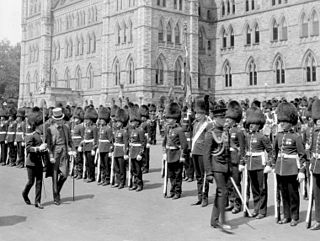
Dominion Day was a day commemorating the granting of dominion status in certain countries. It was an official public holiday in Canada from 1879 to 1982, where it was celebrated on 1 July. That date is now known as Canada Day. There was also a Dominion Day public holiday in the Dominion of Newfoundland from 1907 to 1949, celebrated on 26 September.

The Newfoundland dog is a large working dog. They can be either black, brown, or white-and-black. However, in the Dominion of Newfoundland, before it became part of the confederation of Canada, only black and Landseer coloured dogs were considered to be proper members of the breed. They were originally bred and used as working dogs for fishermen in Newfoundland. Newfoundland dogs are known for their giant size, intelligence, tremendous strength, calm dispositions, and loyalty. They excel at water rescue/lifesaving because of their muscular build, thick double coat, webbed feet, and swimming abilities.

Events from the year 1856 in Canada.
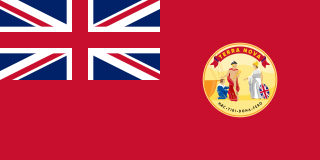
Newfoundland was a British dominion from 1907 to 1949. The dominion, situated in northeastern North America along the Atlantic coast, comprised the island of Newfoundland as well as Labrador on the continental mainland. Before attaining dominion status, Newfoundland was a British colony, self-governing from 1855.

The Royal Newfoundland Regiment is a Primary Reserve infantry regiment of the Canadian Army. It is part of the 5th Canadian Division's 37 Canadian Brigade Group.
James Aloysius McGrath, was a politician and the eighth Lieutenant Governor of Newfoundland, Canada.

Trout River is a small rural fishing village located on the southern coastal edge of Gros Morne National Park in Newfoundland. Trout River was settled in 1815 by George Crocker and his family, who were its only inhabitants until 1880. The community is served by Route 431.
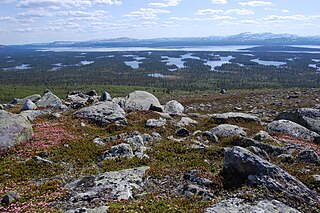
A Rogen moraine is a subglacially formed type of moraine landform, that mainly occurs in Fennoscandia, Scotland, Ireland and Canada. They cover large areas that have been covered by ice, and occur mostly in what is believed to have been the central areas of the ice sheets. Rogen moraines are named after Lake Rogen in Härjedalen, Sweden, the landform's type locality. Rogen Nature Reserve serves to protect the unusual area.
The first brief European contact with Newfoundland and Labrador came about 1000 AD when the Vikings briefly settled in L'Anse aux Meadows. Around 1500, European explorers and fishermen from England, Portugal, Netherlands, France, and Spain began exploration. Fishing expeditions came seasonally; the first small permanent settlements appeared around 1630. Catholic-Protestant religious tensions were high but mellowed after 1860. The British colony voted against joining Canada in 1869 and became an independent dominion in the early 20th century. Fishing was always the dominant industry, but the economy collapsed in the Great Depression of the 1930s and the people voluntarily relinquished their independence to become a British colony again. Prosperity and self-confidence returned during the Second World War, and after intense debate the people voted to join Canada in 1949.
Mount Sylvester is a large formation of rock of the glacier period found in central portion of the Island of Newfoundland. The mountain lies within the boundary of the Bay du Nord Wilderness Reserve of the province of Newfoundland and Labrador, Canada.
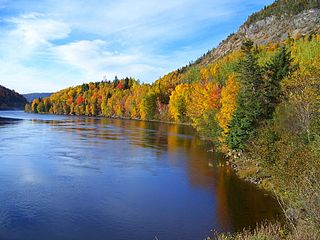
Newfoundland is a large Canadian island off the east coast of the North American mainland, and the most populous part of the Canadian province of Newfoundland and Labrador. It has 29 percent of the province's land area. The island is separated from the Labrador Peninsula by the Strait of Belle Isle and from Cape Breton Island by the Cabot Strait. It blocks the mouth of the Saint Lawrence River, creating the Gulf of Saint Lawrence, the world's largest estuary. Newfoundland's nearest neighbour is the French overseas community of Saint-Pierre and Miquelon.

Mistaken Point Ecological Reserve is a wilderness area and a UNESCO World Heritage Site (2016) located at the southeastern tip of the Avalon Peninsula in Newfoundland and Labrador, Canada which contains the Mistaken Point Formation, the site of Ediacaran fossils representing the oldest multicellular life on Earth. The reserve contains one of the most diverse and well-preserved collections of Precambrian fossils known. In order to view these fossils, visitors must either reserve a guided tour with Natural Areas staff or obtain a permit issued by the Government of Newfoundland & Labrador. For more information about visiting the site, see the Government of Newfoundland & Labrador website via the following link https://www.flr.gov.nl.ca/natural_areas/wer/r_mpe/.
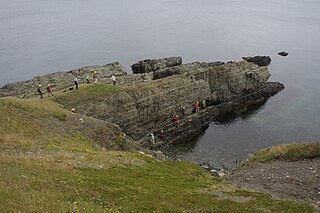
The Terreneuvian is the lowermost and oldest series of the Cambrian geological system. Its base is defined by the first appearance datum of the trace fossil Treptichnus pedum around 541 million years ago. Its top is defined as the first appearance of trilobites in the stratigraphic record around 521 million years ago. This series was formally ratified by the International Commission on Stratigraphy in 2012.
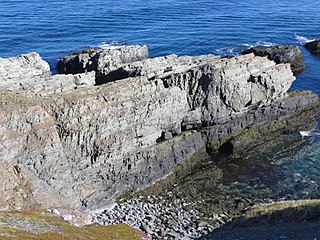
The Chapel Island Formation is a sedimentary formation from the Burin Peninsula, Newfoundland, Canada. It is a succession of siliciclastic deposits, over 1,000 metres (3,300 ft) thick, that were deposited during the latest Ediacaran and earliest Cambrian.

The Chamberlain's Brook Formation is a thin but distinctive geologic formation of dark red calcareous mudstones that crops out from Rhode Island to Massachusetts and, Nova Scotia, New Brunswick and Newfoundland. It preserves fossils, including trilobites, dating back to the lower mid-Cambrian period. Its lowermost member is the Braintree Member and the uppermost member is the Fossil Brook Member.

The Trepassey Formation is a geologic formation that crops out in Newfoundland. It preserves fossils dating back to the Ediacaran period.

The Random Formation is a near-shore rock unit dating to the early Cambrian period, dominated by tidal quartz arenites, but also incorporating intertidal and open-shelf deposits, including glauconitic and mud-cracked mudstones, and red channel sandstones. It was deposited quickly and is approximately 175 m thick. The Blue Pinion Formation was originally recognized as a separate formation, but is now interpreted as an expression of the Random Formation.















